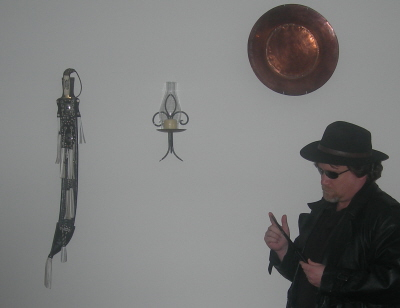|
About This Author
Come closer.
|
Complex Numbers
Complex Numbers
A complex number is expressed in the standard form a + bi, where a and b are real numbers and i is defined by i^2 = -1 (that is, i is the square root of -1). For example, 3 + 2i is a complex number.
The bi term is often referred to as an imaginary number (though this may be misleading, as it is no more "imaginary" than the symbolic abstractions we know as the "real" numbers). Thus, every complex number has a real part, a, and an imaginary part, bi.
Complex numbers are often represented on a graph known as the "complex plane," where the horizontal axis represents the infinity of real numbers, and the vertical axis represents the infinity of imaginary numbers. Thus, each complex number has a unique representation on the complex plane: some closer to real; others, more imaginary. If a = b, the number is equal parts real and imaginary.
Very simple transformations applied to numbers in the complex plane can lead to fractal structures of enormous intricacy and astonishing beauty.
October 3, 2023 at 11:12am October 3, 2023 at 11:12am
| |
On May 16, 1960, in Malibu, California, the red dot appeared for the first time.
Most of the light that we see has a spectral signature, bright at some wavelengths and dim or even nonexistent at others. The sun emits light from all over the spectrum, all of which adds up to white, though the accursed daystar usually appears yellow because most of the blue has been refracted and scattered by the atmosphere.
(There, now you can answer two of your kid's questions: why is the sun yellow, and why is the sky blue. Because it's the same answer.)
The sun's spectrum is, confusingly, called "black-body radiation" by physicists. There's actually a good reason for that, but it's irrelevant to this discussion. It's also (combined with airborne water droplets) why we get rainbows, and why we can use a prism to create an artificial rainbow.
A tree's leaves absorb light that isn't green, bouncing the green back to the eyes of whoever is looking at the tree. But even that reflected light isn't "pure" green; it's just mostly green, and still covers a range of wavelengths, all of which usually average to some shade of green. Except, of course, at this time of year in the Northern Hemisphere, when leaves start to reflect different parts of the spectrum due to chlorophyll reduction... but that, too, is irrelevant to this discussion.
To get light in a narrow band of wavelengths, you need a laser. The word "laser" started out as an acronym (Light Amplification by Stimulated Emission of Radiation), but, as with "radar," now it's a word. They even back-formed the verb "to lase," which is pretty much the opposite of its homonym "to laze," because lasing requires excitement, while lazing requires none.
"Laser" was also a direct derivative of "maser" (the M stood for microwave), which did the narrow band of wavelengths thing, but in a part of the spectrum that we can't see. Thus, masers weren't very good for accompanying Pink Floyd music, or for impressing high school students into wanting to become physics majors.
So, in the late 1950s, after the invention of the maser, scientists pursued the idea of an "optical maser," which would later be termed a laser. The theory was sound; what was lacking was the technology to make it happen, and a material for creating the light.
That material turned out to be ruby.
Not the flawed stones dug up out of mines, but near-perfect lab-created corundum crystal rods. Blind it with high-energy light from a xenon tube (which is like a neon tube, but heavier), do some other technical tricks with internal reflections and whatnot, and zap! Laser.
Now, anyone who's seen Star Wars knows that only the bad guys use red lasers; the good guys use green or blue ones. It would be a few years before those higher-energy photons could get excited enough to become coherent, but it all started with a ruby rod.
And yet, the ruby laser still has important applications—notably, the important job of keeping cats distracted.
And, you know, helping you check out of the grocery store faster. But mostly, the cat thing. |
© Copyright 2025 Waltz Invictus (UN: cathartes02 at Writing.Com). All rights reserved.
Waltz Invictus has granted InkSpot.Com, its affiliates and its syndicates non-exclusive rights to display this work.
|

